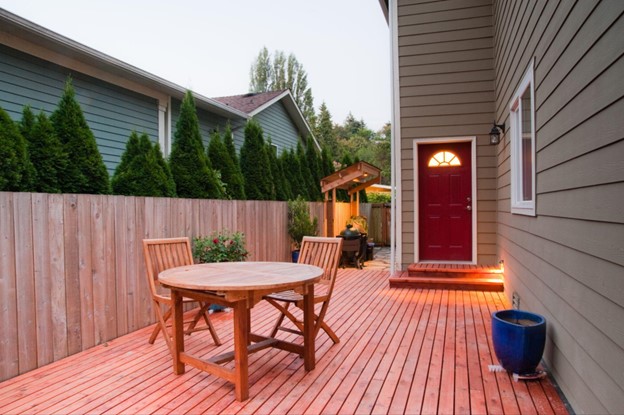It’s hard to deny the allure of an outdoor space adorned with a well-constructed deck. Such an addition to a home not only makes it aesthetically appealing but plays a pivotal role in increasing the property’s market value. The critical factor behind this allure, you ask? Decking materials. From providing a unique touch to your exterior space to adding functional value, these materials determine the longevity and overall quality of your deck. However, choosing the right material is not merely about aesthetics, but rather the Return on Investment (ROI) – a concept that goes beyond the initial deck building costs and looks into long-term value. Exploring the costs and benefits of different decking materials helps homeowners make an investment that truly pays off, a topic this article is set to delve into.
Understanding the Basics of Decking Materials
Decking materials are essentially what the deck is made from – the planks, the framing, and even the screws that hold it all together. They typically fall into three main categories – wood, composite, and plastic. It’s the unique traits of these materials that drive their cost, quality, and eventual ROI. Factors such as ease in installation, durability, maintenance needs, and aesthetic appeal all contribute to the analysis of their Return on Investment. And hence, this analysis becomes a key factor in the decision-making process.
The Advantages of Different Decking Materials
When it comes to deck building costs and the advantages of different decking materials, it’s essential to consider the diverse options available, each offering its own set of benefits.
Wood Decking: The timeless appeal of wood decking is hard to overlook. Its natural look and feel add an inviting charm to any outdoor space. One of its most attractive features is its lower upfront cost, making it an economical choice for many homeowners. In terms of deck building costs, wood decking tends to be budget-friendly, and this initial investment can yield a significant return on investment (ROI). Additionally, wood decks are highly sought after in the property market due to their aesthetic appeal, further enhancing the ROI for homeowners.
Composite Decking: Composite decking strikes a balance between cost and durability, addressing both aesthetic and practical concerns. It’s a clever fusion of wood and plastic, offering a product that is not only more durable but also demands less maintenance than pure wood. While the upfront deck building costs for composite materials might be slightly higher than wood, the long-term savings on maintenance and repair work can significantly contribute to a positive ROI. This makes composite decking an excellent choice for those seeking a deck that stands the test of time while keeping deck building costs in check.
Plastic Decking: At the upper end of the spectrum, plastic decking represents a high-resilience option. Its initial deck building costs may be higher, but it offers minimal maintenance requirements and long-term cost-effectiveness. Plastic decking is known for its durability and resistance to harsh weather conditions, ensuring that your investment remains strong and visually appealing for many years to come. This durability and minimal upkeep not only provide peace of mind to homeowners but also contribute to a robust ROI over the long term.
The Costs Involved in Utilising Different Decking Materials
The choice of decking material depends on individual homeowners’ preferences and needs. Wood, composite, and plastic decking each have their unique advantages and considerations in terms of deck building costs. Whether you prioritize the classic beauty of wood, the balance of cost and durability with composite, or the long-term resilience of plastic, there’s a decking material to suit your style, budget, and expectations.
The initial investment varies across the three types, with wood being the least expensive and plastic the most. However, these costs only tell part of the story. Long-term maintenance, the impact of weather conditions, lifespan, and the eventual resale value all contribute to a more nuanced view of costs. For instance, while wood may be affordable upfront, its requirement for consistent upkeep might drive up its long-term costs. It’s this broader perspective on costs that feed into the overall ROI equation.
Case Studies: Decking Material ROIs in Real Scenarios
Exploring different case studies provides a hands-on understanding of the ROI of these materials. For instance, a home in a mild climate might find minimal differences in wood and composite ROIs due to its temperate weather. Conversely, for a seaside home, salt and moisture resistance of plastic decking might offer a higher ROI despite its higher initial cost. Various factors, such as local climate, lifestyle and usage, can significantly impact the material’s performance and, therefore, its ROI.
Making an Informed Choice: Balancing Costs and Benefits
Choosing the materials for a deck is much like a balancing act between initial costs and long-term benefits. To reap the highest possible ROI, homeowners need to consider their lifestyle – how much maintenance are they willing to undertake? What are the climatic conditions – does the material need to withstand harsh weather? What’s the allocated budget? Seeking professional consultation may provide helpful guidance to address these considerations and result in a well-informed, rewarding decision.
In conclusion, understanding the ROI of different decking materials goes a long way in optimising both construction costs and long-term benefits. It gives you a deeper insight into how wood, composite and plastic decking can offer a unique blend of aesthetics, durability and cost-effectiveness. So, before you invest in building a deck, consider the long-term impact of your material choice. Remember – a well-informed homeowner is a savvy investor. Don your investigator’s hat, explore your options, and you’ll be well on your way to a beautiful deck that offers a solid return on your initial investment.






